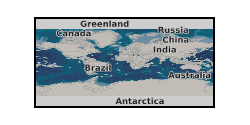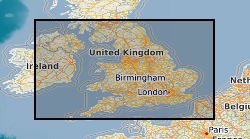2002
Type of resources
Topics
Keywords
Contact for the resource
Provided by
Years
Formats
Representation types
Update frequencies
Scale
Resolution
-
The University of Wales, Aberystwyth, 1290mhz mobile wind profiler - now referred to as the University of Manchester mobile wind profiler - was operated at the Mace Head Research Facility in County Galway, Ireland, as part of the North Atlantic Marine Boundary Layer EXperiment (NAMBLEX) field campaign in August 2002. During this period the mobile wind profiler obtained vertical profiles of the horizontal and vertical wind components. For each signal beam profiles of the signal to noise (SNR) ratio and spectral widths were also taken.
-

Regional property grids of the Utsira Sand based on mapping from 2D regional seismic lines and geophysical logs. Grids include: Top Utsira depth, Base Utsira depth, Utsira isopach, Utsira porosity, Utsira porosity effective thickness, Utsira proportion clean sand. 2 km grid spacing. SACS/SACS2 EU project.
-
This is a copy of The Berlin Stratospheric Data Series provided to the BADC by K. Labitzke and her collaborators (2002) as a CD from the Meteorological Institute, Free University Berlin. This data set contains temperature and geopotential height data on the 100, 50, 30, 10 mb pressure surfaces produced at the Meteorological Institute, Free University of Berlin, from radiosonde data and rocket observations. This data series also contains summer, winter and annual trends and variability of the data, climatological monthly mean temperature and geopotential height at 30 mb, and intercomparisons with other data series. There are also sections on the quasi-biennial oscillation (QBO) and the global signal of the 11-year sunspot cycle in the stratosphere.
-
The SLIMCAT (Single Layer Isentropic Model of Chemistry And Transport) Reference Atmosphere for UTLS-Ozone was a set of example output from the SLIMCAT three-dimensional chemical transport model (CTM). It includes three-dimensional global fields of chemical (and sometimes meteorological) variables as computed for twelve dates in 1997, near the middle of each month. This data set includes 12 files, each of them corresponding to one output time near the middle of each month of Year 1997 (12 Jan, 11 Feb, 13 Mar, 12 Apr, 12 May, 11 Jun, 11 Jul, 10 Aug, 19 Sept, 19 Oct, 18 Nov, 18 Dec). Each file contains the calculated 3-D distribution of 37 chemical species or families and 6 meteorological variables. The model used is the SLIMCAT chemistry transport model (CTM). The model was run from October 1991 and forced by the UK Met Office analyses. The model used 18 isentropic levels. The vertical coordinate in the data files is the globally averaged altitude. The real lat/lon-dependent altitude is given in the ALT field recorded in the files. The THETA field gives the real model theta levels (which are constant with latitude/longitude). Data from Martyn Chipperfield, University of Leeds. NERC Research Programme UTLS-Ozone (Upper Troposphere and Lower Stratosphere) and National Centre for Earth Observation (NCEO).
-

The BGS Geoscience Thesaurus contains approximately 6000 descriptor terms for concepts in the geoscience and related subjects. Some entries have scope notes to further explain the term. The original source of the data was the Australian Mineral Foundation thesaurus of geoscience; some terms have been added or updated to suit BGS needs and the content will continue to be updated as required. The thesaurus includes synonyms to descriptor terms, hierarchical relationships, symmetric (see also) relationships and lapsed (deprecated) term replacements.
-

Derived from data collated from the 2005 Aggregate Minerals Survey, carried out by BGS for the Department for Communities and Local Government (CLG) which provide an in-depth and up-to-date understanding of regional and national sales, inter-regional flows, transportation, consumption and permitted reserves of primary aggregates for England and Wales. The information is used to monitor and develop policies for the supply of aggregates. This data set depicts the flow of crushed rock aggregate between the regions of England and Wales. The data originator also has similar data for sand and gravel and also the same data derived from the 1997 and 2001 Aggregate Minerals Surveys.
-
Global Brightness Temperature imagery from the Cloud Archive User Service (CLAUS) project. This project produced a long time-series of global thermal infra-red imagery of the Earth using data from operational meteorological satellites, which was used in validating atmospheric General Circulation Models. The CLAUS archive currently spans the period 1st July 1983 - 30th June 2009. Responsibility for maintaining and updating the CLAUS archive resides with the Environmental Systems Science Centre (ESSC). The source data used in CLAUS are the level B3 (reduced resolution) 10 micron radiances from operational meteorological satellites participating in the International Satellite Cloud Climatology Programme (ISCCP) and were obtained from the NASA Langley Atmospheric Sciences Data Center (LASDC). During the CLAUS project the B3 data were processed to create a uniform latitude-longitude grid (or image) of Brightness Temperature (BT) values at a spatial resolution of 0.5 by 0.5 degrees and temporal resolution of three hours. Information at the grid point level about the satellites used in generating each BT image, and the type of interpolation applied, was held in two supplementary quality files. The B3 data were also rigorously quality controlled to remove residual noise and navigation/calibration errors that were noticed in the original processing. The 0.5 degree resolution data were updated and supplemented by a new product at one-third degree spatial resolution for use in process studies. These higher resolution data are also being used to create monthly animations for educational purposes.
-
This data set details soil pH values and soil moisture values from experimental plots at a field site at Sourhope, Scotland, between 1998 and 2002. Data were collected as part of the NERC Soil Biodiversity Thematic Programme, which was established in 1999 and was centred upon the intensive study of a large field experiment located at the Macaulay Land Use Research Institute (now the James Hutton Institute) farm at Sourhope in the Scottish Borders (Grid reference: NT8545019630). During the experiment, the site was monitored to assess changes in above-ground biomass production (productivity), species composition and relative abundance (diversity). Full details about this dataset can be found at https://doi.org/10.5285/a35d0ded-b422-4af3-8f74-e70249fc9788
-
Regular temperature, rainfall and other weather data, as collected between February 1999 and September 2002 from an on-site Automatic Weather Station, located on experimental plots at Sourhope, Scotland. Data were collected as part of the NERC Soil Biodiversity Thematic Programme, which was established in 1999 and was centred upon the intensive study of a large field experiment located at the Macaulay Land Use Research Institute (now the James Hutton Institute) farm at Sourhope in the Scottish Borders (Grid reference: NT 8545 1963). During this time, the site was monitored to assess changes in above-ground biomass production (productivity), species composition and relative abundance (diversity). Full details about this dataset can be found at https://doi.org/10.5285/e6e835ae-99e6-445e-b0dc-0d0db44e310a
-
The data set comprises biomass values and mineral nutrient values from experimental plots located at Sourhope, Scotland. On five occasions throughout each of the 1999, 2000, 2001 and 2002 growing seasons, grass cuttings were collected from a 50 x 50 cm cell area from each of the four main sub-plots within each of a set of experimental main-plots, and biomass values calculated. In addition, mineral nutrient analysis was carried out for the July 1999 grass cuttings. The work was part of the NERC Soil Biodiversity Thematic Programme, which was established in 1999 and was centred upon the intensive study of a large field experiment located at the Macaulay Land Use Research Institute (now the James Hutton Institute) farm at Sourhope in the Scottish Borders (Grid reference: NT 8545 1963). During the experiment, the site was monitored to assess changes in above-ground biomass production (productivity), species composition and relative abundance (diversity). The primary aims of the Programme were to achieve simultaneously an understanding of the biological diversity of the soil biota and the functional roles played by soil organisms in key ecological processes. In seeking to achieve these aims, 24 separate research projects were funded to study soil structure, soil processes (such as the carbon and nitrogen cycles) and the roles of micro-fauna and flora (Bacteria, Nematoda, Protozoa and Fungi), microarthropods (including Collembola and Acari), invertebrate root feeders (Tipulid, Bidionid and Scarabeid larvae), meso-fauna (such as Enchytraeidae) and macro-fauna (including Megadrili, Mollusca and Coleoptera). Full details about this dataset can be found at https://doi.org/10.5285/1a278fbf-b8b2-472d-9100-5fb432095f63
 NERC Data Catalogue Service
NERC Data Catalogue Service